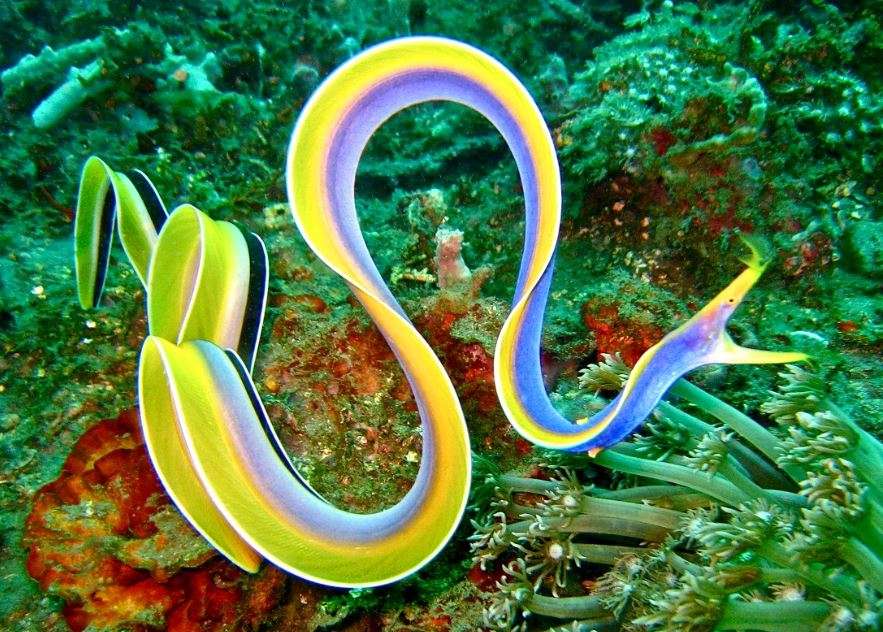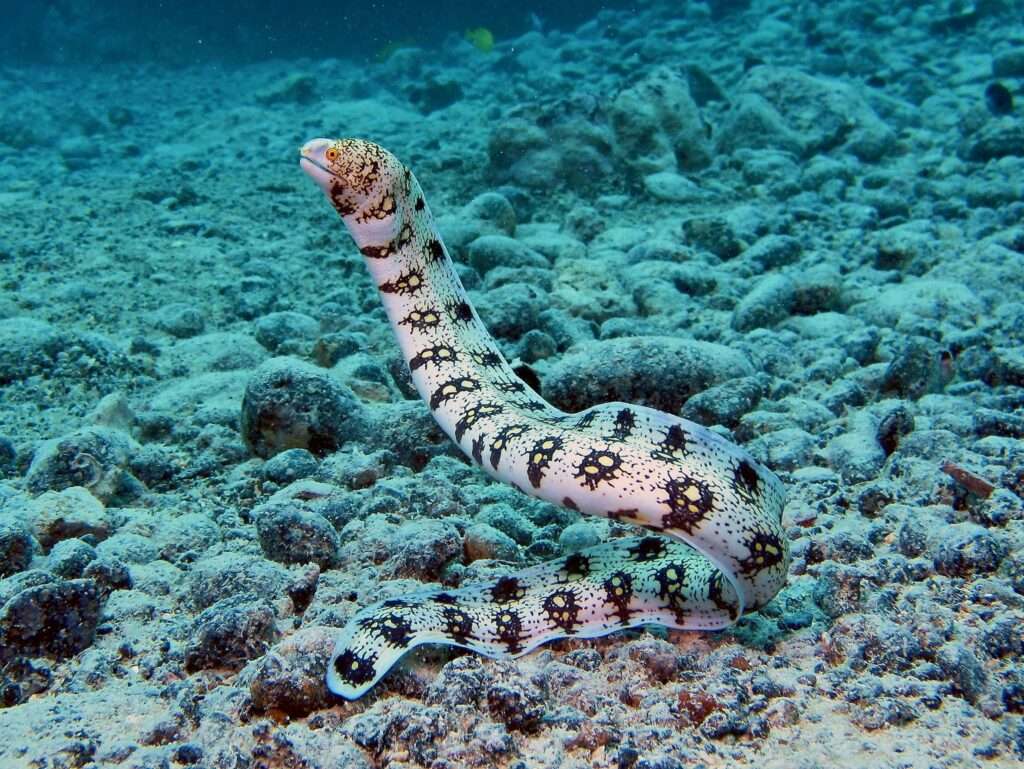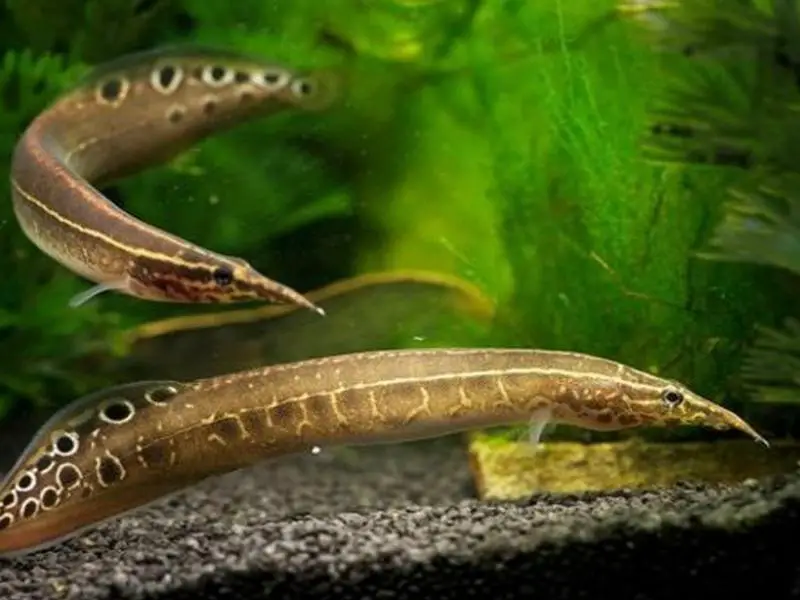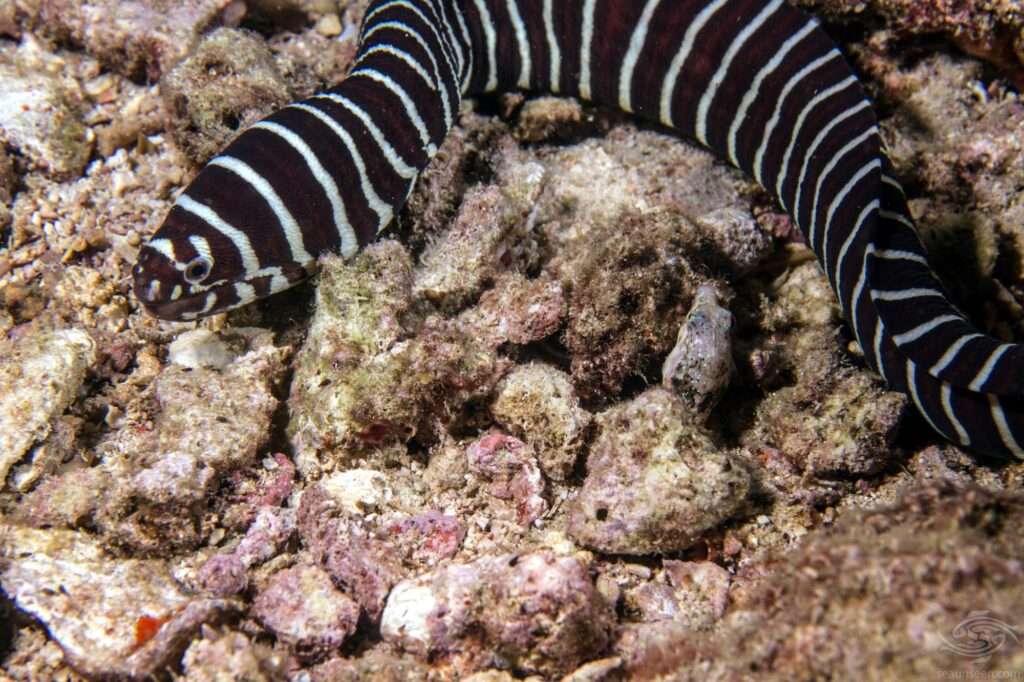
Beginning its life as a male, the Ribbon Eel is completely black from head to toe and has a yellow dorsal fin. The eel’s face changes to a vivid yellow to match the tip of its dorsal fin after it reaches the age of 23 to 32, and its black body changes to a vivid blue. The Ribbon Eel begins to develop female reproductive organs around 33″ and, if necessary, will transform into a female that is yellow to blue yellow in hue (appears green at times). Two long tubular protrusions on their nose each have an oversized fan-like tip. They lack scales, like like all other eels, and have continuous dorsal and pelvic fins instead of having bone plates over their gills. Even though the eels in captivity have evolved female organs and are capable of laying eggs, they occasionally stay black. These eels are slender and compressed, but they may grow to a height of 3.9 feet (1.2 metres), and they have a lifespan of around 20 years, but it may be less in captivity. The finest keepers of these eels are experienced aquarists.
R. ambonensis was previously the name of the species for these eels when they were blue or male. They are the same eel, only the black colour is the juvenile form, it was eventually discovered. However, when hearing the name White Ribbon Eel, that refers to Pseudechidna brummeri, which is a close related, they are not mistaken with other eels because it is not nearly as difficult to care for as the Ribbon Eel. The White Ribbon Eel is entirely white, lacks the pronounced nasal protrusions, and has a more rounded snout. It may also have black freckles.
It’s an interesting sight to see Ribbon Eels swimming since they resemble one of those ribbon toys you can wave back and forth. They prefer good water circulation and a very dark hiding area.
Habitat
Garman published the first description of the Ribbon Eel, Rhinomuraena quaesita, in 1888. Previously, it was believed that the male colour type, which is blue with a yellow dorsal fin, belonged to a distinct species. So, until 1990, when it was established that these eels are identical, the name R. ambonensis was used. They are also referred to as Blue Ribbon Eels, Black Leaf Nosed Moray Eels, Ribbon Eels, and Ribbon Morays. When broken down, the name Rhinomuraena has two meanings. Rhinos is Greek for “nose,” while muraena is Latin for “moray eel.” This most likely refers to the long, tubular nostrils at the tip of the snout that fan out at the ends.
The Indo-Pacific region, which stretches from East Africa to the Tuamotu Islands and from southern Japan to New Caledonia and French Polynesia, including the Marianas and the Marshall Islands, is home to the Ribbon Eel. They can be found in seaward lagoons and reefs, concealed in sand, mud, or rubble with their heads jutting out, at depths ranging from 3 feet to 219 feet. They are quite elusive (1 to 67 m). They eat little fish that are easily eaten whole as food. Juveniles are typically seen alone, but there may be several adults nearby, occasionally sharing a hideout.
Traits
The Ribbon Eel occurs in three different color varieties, but all three feature a dorsal fin with a yellow tip, and they all begin life as males. Before they reach a height of 23 to 32 inches (65 to 80 cm), which is when they begin to develop their blue color, juveniles start off with a black head and body. The rest of the body changes to a stunning bright blue color, except for the nose and lower mouth, which turn a bright yellow tint. The Ribbon Eel gains female sex organs when it is 33 inches (85 cm) long and can switch from male to female at will. Females change to a yellowish blue, green, or yellow color, however some individuals remain blue in the back of their bodies.
In captivity, the black pigment might occasionally last into adulthood for unexplained causes. These eels feature 2 tubular nostrils that stretch out into an exaggerated fan-like look, 3 fleshy tentacles on the tip of their lower jaw, and a sharp projection at the tip of their snout. They swim in an undulating motion that resembles the way a thick ribbon might seem when waved back and forth, while having a thin, compressed body. They have a single row of slanted-back teeth in their jaw that are tiny and thin. The lifespan of an adult ribbon eel, which may grow to a maximum length of 3.9 feet and has 270 to 286 vertebrae, is 20 years in the wild but only 4 to 7 years in captivity.
Keeping as Pet

Food
Carnivorous Ribbon Eels devour extremely small fish that swim close to their hiding place. To get them to start eating, give them live rosy reds, guppies that are orange or red in color, and little goldfish. They should be transformed into silversides and other marine meat. Every other day, give them food. Although they occasionally consume krill or feeder shrimp, their diet screams FISH! They do not eat crab or shrimp. Once they are eating live items and marine fish flesh, feed them till they are satisfied every two to three days.
Face Difficulty to Keeping in Aquarium
The Ribbon Eel requires a lot of maintenance, thus only experienced aquarists should keep one. The tank needs to be at least 4 feet long and hold 55 gallons at a minimum. The Ribbon Eel needs a smaller tank because, in contrast to other eels, it is exceedingly thin and slender and produces less waste than an eel with a deep body. The best time to feed them until they are accustomed to prepared foods is when the lights are dim or out, close to dusk. It appears that keeping them alone may not be the best advice. Several aquarists have had some luck feeding these lovely animals.
Due to the lack of nutrition in these items, freshwater feeder fish can be employed to aid in feeding even though they are not good for Ribbon Eels. One aquarist noticed that ribbon eels appear to favour little feeder fish that are red or orange. When there are multiple Ribbon Eels in the tank, one of two approaches—creating a feeding frenzy—will be helpful. One set is for a single Ribbon Eel and one step by step is for a pair. If the arrangement is poor, they won’t ever eat. Only give them one fish per day throughout the transition period to frozen/thawed fish in order to keep them ravenous and hasten the process. In other words, the procedure will take significantly longer if you feed them two or three fish and then a few days pass.
Table





